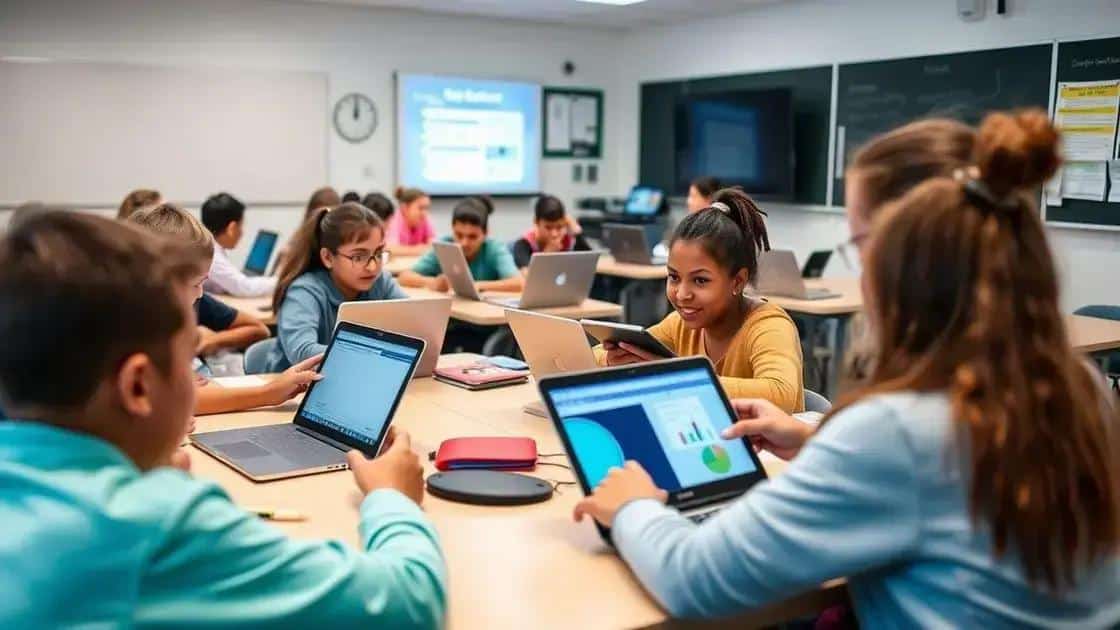K-12 education: Transforming the future of learning

Anúncios
K-12 education technology enhances learning by making it interactive, providing personalized experiences, and preparing students for a technology-driven future, while facing challenges like access disparities and the need for teacher training.
K-12 education is crucial in shaping the future of our children. Have you ever paused to think about how it molds their learning experiences? In this discussion, we’ll dive into its impact and significance.
Anúncios
The importance of K-12 education in child development
K-12 education plays a vital role in shaping the overall development of children. It lays the foundation for their future learning and personal growth. During these formative years, children not only acquire knowledge but also develop essential life skills. This education system nurtures their social, emotional, and cognitive abilities.
In addition to academics, K-12 education impacts children’s social interactions. They learn to work with peers, resolve conflicts, and foster relationships. These skills are crucial as they transition into adulthood. Educators use various methods to promote these competencies, ensuring that students are well-rounded individuals.
Key Areas of Development in K-12 Education
During their time in K-12 education, children focus on several key areas that contribute to their growth:
Anúncios
- Critical Thinking: Learning to analyze, evaluate, and create solutions to problems is essential. This skill prepares students for real-world challenges.
- Social Skills: Interacting with peers helps students develop empathy and teamwork abilities.
- Emotional Intelligence: Understanding their own emotions and those of others fosters a supportive learning environment.
- Academic Readiness: A strong foundation in subjects like math and reading prepares students for future challenges in higher education.
The influence of K-12 education extends beyond the classroom. It shapes children’s identities and helps them navigate societal expectations. By engaging in extracurricular activities, students can also explore their interests, develop talents, and build friendships.
Furthermore, the role of families in K-12 education cannot be underestimated. Parental involvement significantly enhances a child’s learning experience. Parents who engage with their children’s education foster a love for learning and motivate them to succeed.
Ultimately, the importance of K-12 education in child development is profound. It molds the next generation of thinkers, leaders, and responsible citizens. By prioritizing this education stage, we invest in a brighter future for our children and society.
Innovative teaching methods in K-12 settings

Innovative teaching methods are transforming K-12 education, making it more engaging and effective for students. With the rapid changes in technology and learning styles, teachers are adopting new strategies to enhance the learning experience. These methods not only capture students’ attention but also promote deeper understanding.
One exciting approach is project-based learning. In this method, students work on real-world projects that require critical thinking and collaboration. For instance, instead of just reading about ecosystems, students might create a garden project to explore plant life. This hands-on experience helps them connect theory with practice.
Benefits of Innovative Teaching Methods
Innovative teaching methods provide numerous benefits:
- Enhanced Engagement: Students are more interested and invested in their learning.
- Development of 21st Century Skills: These methods help students build skills like creativity, communication, and problem-solving.
- Personalized Learning: Teachers can tailor instruction to meet individual student needs.
- Collaboration Opportunity: Students frequently work in teams, fostering social skills.
Another great method is the use of technology in the classroom. Interactive tools such as tablets, educational apps, and online resources make lessons more dynamic. For example, using educational games can make math practice feel like play rather than work. Teachers integrate these tools to promote active participation.
Moreover, incorporating flipped classrooms is gaining popularity. In this model, students review lesson content at home and engage in hands-on activities in class. This method allows teachers to focus more on facilitating discussions and supporting students during collaborative work.
Each of these methods contributes to a richer educational environment. By embracing innovative teaching methods, educators not only enhance student learning but also prepare them for the future. The emphasis on active participation ensures that students develop important skills that will serve them well beyond the classroom.
Challenges faced by K-12 educators today
The landscape of K-12 education is constantly evolving, and teachers face many challenges today. One major issue is the shift to remote learning. With technology becoming a primary tool, educators must adapt their teaching methods to engage students in a digital environment. This adjustment can be difficult, especially for those who are accustomed to traditional classroom settings.
Another pressing challenge is addressing diverse learning needs. Classrooms today include students from various backgrounds with different abilities. Teachers must find ways to tailor instruction to meet these various needs, ensuring that every student can succeed. This often requires additional resources and training that may not be readily available.
Key Challenges Faced by Educators
Several key challenges impact K-12 educators:
- Inadequate Funding: Many schools struggle with limited budgets, affecting resources for materials and technology.
- High Teacher Turnover: Retaining qualified teachers is a significant concern, impacting the stability of classrooms.
- Time Constraints: Teachers often have limited time to cover extensive curriculum content, making effective teaching harder.
- Parental Involvement: Not all families can actively participate in their children’s education, which can hinder student progress.
Additionally, the pressure to meet standardized testing requirements can be overwhelming. Educators may find themselves focusing more on test preparation than on meaningful learning experiences. This focus can lead to a narrow curriculum that does not fully engage students.
Moreover, issues such as student behavior, mental health, and social challenges require educators to be not only teachers but also mentors and counselors. Many educators find themselves stretched thin, trying to support students in multiple ways. Balancing their teaching responsibilities with these additional roles can create significant stress.
Despite these challenges, many K-12 educators remain committed to their students’ success. They continuously seek innovative strategies to create engaging learning environments, showing resilience in the face of adversity. By identifying and addressing the difficulties they face, educators can develop better approaches to meet the evolving needs of their students.
The role of technology in K-12 education

Technology plays a crucial role in K-12 education, reshaping how students learn and how teachers instruct. With the rise of digital tools, classrooms are becoming more dynamic and interactive. Students can now access a wealth of information at their fingertips, making learning easier and more engaging.
One significant advancement is the use of educational software. Programs designed for K-12 education allow students to practice subjects like math and reading in a fun and interactive way. These software tools can adapt to each student’s learning pace, providing personalized experiences that traditional methods often cannot achieve.
Benefits of Technology in Education
Integrating technology into the classroom brings many benefits, including:
- Enhanced Engagement: Interactive lessons keep students focused and interested in the topics.
- Collaboration Opportunities: Digital platforms enable students to work together on projects, even when not in the same physical space.
- Access to Resources: Students can explore videos, articles, and tutorials that supplement their learning and broaden their understanding.
- Preparation for the Future: Familiarity with technology equips students for the digital world they will enter after school.
Moreover, technology allows teachers to track student progress more effectively. Using online tools, educators can gather data on student performance and adjust their teaching strategies accordingly. This feedback loop helps identify areas where students may need more support, ensuring that no one falls behind.
Another notable advancement is the growth of online learning platforms. These platforms give students options outside the traditional classroom. E-learning has seen tremendous growth, especially as technology improves. Students can learn at their own pace, making education more flexible.
Despite the benefits, it’s important to recognize some challenges. Not all students have equal access to technology, which can create disparities in learning. Schools must find ways to bridge this gap and ensure that every student can benefit from the advantages technology provides.
Overall, the role of technology in K-12 education is transformative. It not only enhances the learning experience but also prepares students for a technology-driven world. By embracing innovation, educators can create relevant and impactful educational experiences.
FAQ – Frequently Asked Questions about K-12 Education Technology
How is technology improving K-12 education?
Technology enhances K-12 education by making learning interactive and engaging, allowing students to access information easily.
What are some examples of educational software used in schools?
Some popular educational software includes programs for math practice, reading comprehension, and interactive learning games.
What challenges do schools face when integrating technology?
Schools often face challenges such as limited funding, unequal access to technology, and the need for teacher training.
How does technology prepare students for the future?
By familiarizing students with digital tools, technology equips them with essential skills needed in a technology-driven workforce.






